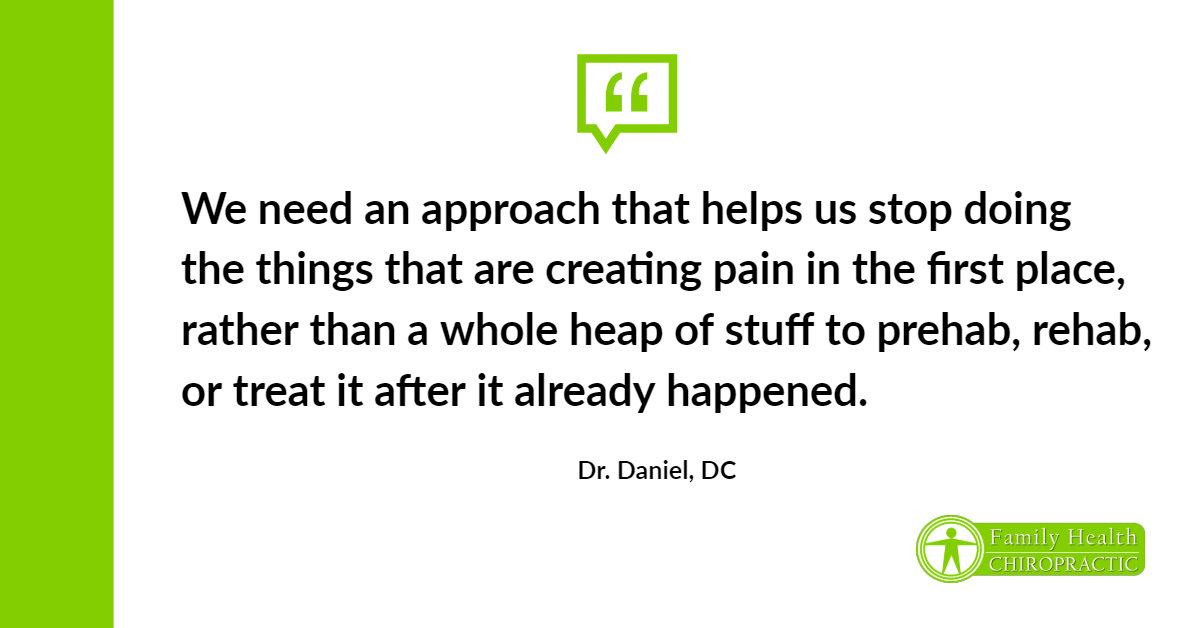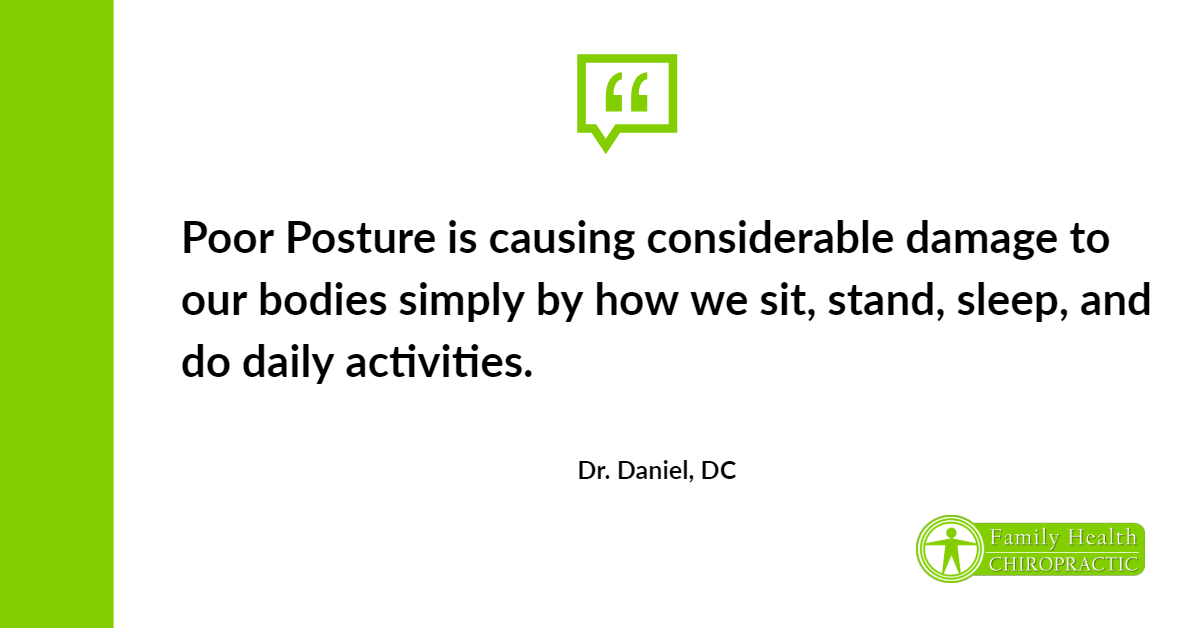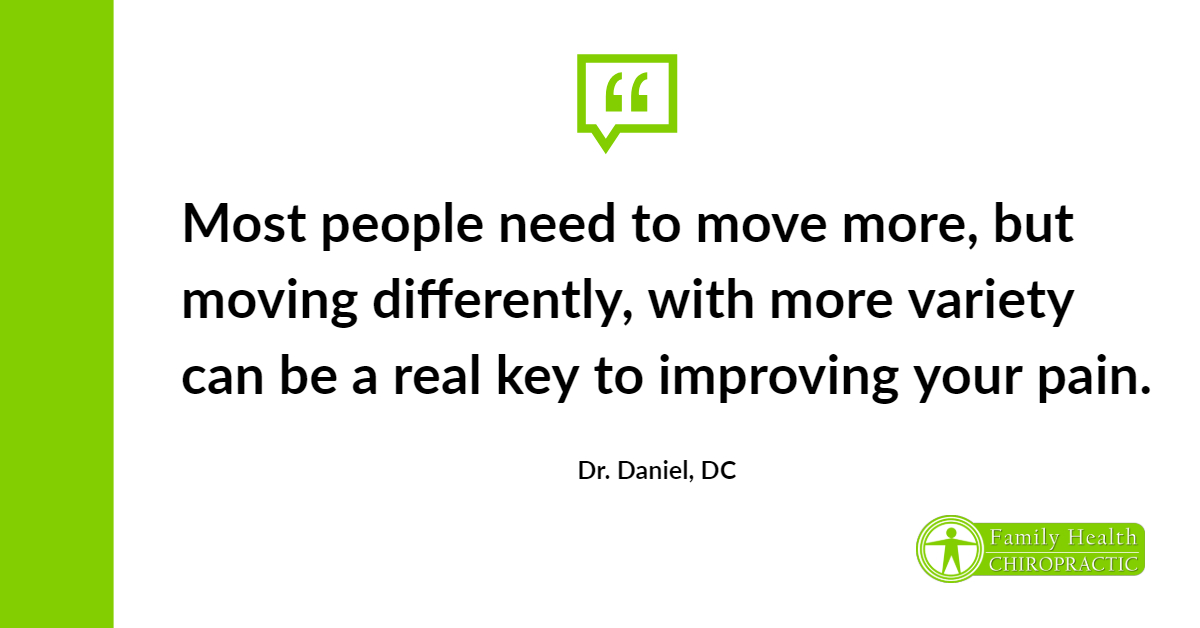I've been in practice for more than 10 years and the bulk of my care is definitely pain-based.
I am regularly contacted by fellow cross-fitters, personal trainers, fitness enthusiasts and even other chiropractors about chronic pain and how to resolve it.
In this article I'd like to offer a few strategies that you can consider when it comes to troubleshooting chronic pain.
First, Stop.
Stop and think about what, when and how your pain occurs.
What specific movements and positions do you have to put yourself into, to cause the pain? And…
Where is the breakdown occurring? Is it in the middle of night? Is it at rest or when you're physically using your shoulder?
Does your pain occur at the end range of a movement, during or at rest?
Obviously I wouldn't expect you to diagnose what specific muscle, ligament or tendon is causing your pain, but there is a lot you can do on your own to initiate healing and even resolve your problem on your own.
What I mean by STOP, is learn how to remove the negatives. In other words, stop doing the activity that is causing your pain.
This doesn't mean you need to quit moving entirely. In fact, there's more to consider than just what you do in the gym.
The real reason reason why we experience pain, is because of our daily activities. It’s not the way you stretch before a workout. It’s not the way you let your elbows flare in the bench press or how you do your crunches.
While none of those things are good choices, they may not be as harmful as simpler, non-training tasks…. such as how you hold your smart phone all day or hunch over a computer for 2-3 hours at a time.
Everyone wants to know what they need to do, what they need to ADD to their programming to fix their pain problems.
And while I'm a big fan of corrective exercise programs, truth be told, a lot of them aren’t working for people because we neglect the small stuff.
We need an approach that helps us stop doing the things that are creating pain in the first place, rather than a whole heap of stuff to prehab, rehab, or treat it after it already happened.
No amount of rehab or prehab can possibly undo the damage you are doing to your body daily if you are not mindful and willing to stop doing the things that hurt it in the first place.
So the first thing to do is STOP, and think about the position(s) you're putting yourself into daily.
Fix Bad Posture & Improve Movement
Scientists and practitioners love to argue about the best positions that humans should be putting themselves into everyday.
When it comes to shoulder, elbow, wrist and hand injuries, poor posture must absolutely be addressed and no one can do that but you.
Poor posture is causing considerable damage to our bodies simply by how we sit, stand, sleep, and do daily activities.
That said, there are millions of people in non-industrialized countries who sit and stand for extended periods of time, and do hard manual labor, and have no neck, back, or shoulder pain.
It is how they sit, stand, sleep, and work that is the game changer. The way they position their body throughout the day is what keeps them out of pain.
Some of the biggest breakthroughs I have seen in someone's health happened after I helped them to stand, sit, sleep, and do mundane daily tasks (i.e., move) better.
Some examples of things we address include:
- One-sided dominance: driving, using their computer mouse, brushing their teeth, using their phone with the same hand all the time
- Sleeping on their painful side, or sleeping on their stomach with their arm overhead
- Carrying a heavy bag over one shoulder
- Sitting rotated in one direction in an office environment
- Sitting in bed cross-legged, hunched over a computer for hours
- Vacuuming, lifting furniture, and twisting in a flexed position
- Sitting on their wallet in the back pocket
If you are in pain, take a long look at what your day-to-day movement habits are like.
This is where the damage is done.
Does Your Programming or Technique Suck?
Check your exercise selection including order, load, volume, and technique.
This is extremely crucial when it comes to resolving pain.
Most of the time, we are simply doing too much of the same type of exercise over and over. This can be observed in weight training, running, swimming, cycling and even yoga.
Often you will see that athletes do the same kind of routines over and over with little thought in the movement patterns they're training.
If you have shoulder problems and train regularly, I can say with little hesitation that there is probably something amiss in your programming that is putting your shoulder into pain.
For instance, if you spend a lot of time in flexion (think arms overhead) and do a lot of pressing in general, this is a recipe for disaster. Check your technique and specifically look at the position of your setup for your exercises.
Does Your Work Environment Suck?
If you cannot stop doing what is causing you pain, for example if it’s your work, your only other option is to try and vary what you are doing.
Try to move from a seated to a standing workstation from time to time.
Walk to your meetings or set a timer and do some lunges, standing squats and push ups every few minutes.
If you have to hold iPads or stare at smart phones all day, then make sure you spend a few minutes letting your head hang back and open up your chest. Think about how you can counteract the stressful positions that your work or daily tasks place on your body.
Most joint problems are from overuse, repetitive movements and patterns, and over-specialization.
Most people need to move more, but moving differently, with more variety can be a real key to improving your pain.
Work Inside Out
What comes first in corrective exercise: mobility, flexibility, or strength?
Trick question! The answer is alignment.
In human movement, everything is going to be dictated by neurological integrity. Your brain and spinal cord (which is protected by the spine) are central to everything.
We often damage our joints from the way they are loaded or stressed, and spine alignment is a big player in how these stresses are distributed through the joints.
Neck problems can be shoulder pain in disguise caused by spine rotation or uneven clavicles.
Low back pain can be ankle dysfunctions or due to uneven hips.
Bad Hips can be due to poor ankle mechanics, etc.
It is all connected. Some people cannot stand the idea of manipulations or adjustments, but they are necessary.
You can torque, pull, and stretch on a particular area all you want, but if the joint needs to be manipulated and put back into place, no amount of foam rolling is going to correct that.
New Patient?






